For policymakers grappling with global energy shortages and households scrambling to pay record high utility bills, some unwelcome news: This year’s energy crisis is going to look mild once next year’s kicks in. It is winter 2023-2024 that is going to be the real crisis. Any current energy planning that fails to account for next year and beyond is jumping out of the frying pan and into the fire—where this winter is a problem, 2023’s may be a catastrophe.
The immediate problem is simple: There is not enough fuel, and therefore not enough electricity, so prices have skyrocketed for both. To a large extent, this is a result of decreased Russian exports of oil, natural gas, and coal, which have been hit by western sanctions and other policy efforts to curb Russian revenues funding atrocities in Ukraine. Most Russian fuel supplies are still reaching international markets, however, because countries like China and India are happy to buy discounted product from a not-quite-fully marginalized Kremlin. But Russian exports are down, too, approximately 18% in August compared to February. Notwithstanding a current drop in natural gas prices now that European storages are mostly full, prices have been so high as a consequence of tighter supplies that Russian President Vladimir Putin is enjoying record energy revenues—over €200 billion since the start of the war on February 24. In turn, markets are tight globally and countries are competing for limited supplies in what has become a zero-sum energy game.
This year’s energy shortage is not just a Russia problem, however. Other factors keeping energy supply below demand are the unexpected surge in economic and industrial activity as countries awoke from COVID-19, refining capacity shortfalls caused by myriad fires, labor strikes, and other maintenance activities, and overall inflation that puts upward pressure on prices independent of supply constraints. The knock-on effect—high prices and lower than normal generation—on electricity are because most power plants burn oil, coal, and natural gas. Utilities can neither raise prices on consumers without regulatory approval nor buy fuel imports with unchecked debt under existing laws that prevent risky behavior by critical service providers. Many power plants around the world are struggling to continue generating electricity.
Meanwhile there are not nearly enough nuclear, wind, solar, and other non-fossil fuel alternatives, and hydroelectric plants worldwide are suffering due to climate change droughts. The end result is current or forecast brown and blackouts across the developing world, in parts of Europe, and maybe in the U.S., too, according to the U.S. Federal Energy Regulatory Commission. Developing countries are the worst off because they have less ability to absorb higher energy costs.
This is the situation we are in now, which winter will exacerbate, but it is going to be a walk in the park compared to next year. To start with, this year is not as bad as it could be. Although this year’s winter will prove uncomfortable and expensive, Europe is nonetheless in a surprisingly good position. Bloc-wide, natural gas storages are now well over 90% of the annual target, which is actually at least 15% higher than their levels a year ago. This is not enough to heat and power the continent through a cold winter, or even a normal winter at current consumption levels. But barring any unforeseen calamities, current natural gas reserves are probably enough for one winter if the E.U. succeeds in implementing both its voluntary and mandatory cumulative 15% electricity usage reduction policies.
Of course, a warm winter and a 15% consumption reduction is a best case scenario, and it is far from certain it will play out. During a cold snap in September and October, Poles were burning trash to stay warm. Europeans are hoarding firewood, and blackouts are already occurring in some countries. And, unfortunately, warm weather now coupled with energy subsidies are likely to disincentivize conservation of existing energy resources. Alexey Miller, CEO of Russia’s Gazprom, thus estimated in mid-October that European countries could be short about one-third, 800 million cubic meters (mcm) of natural gas per day during a cold spell this winter even with gas storages full now.





